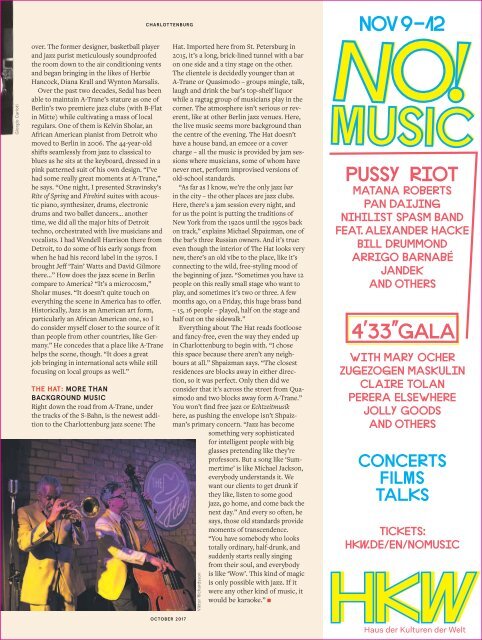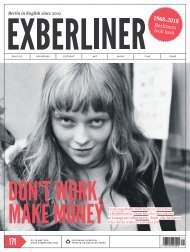EXBERLINER Issue 164, October 2017
Create successful ePaper yourself
Turn your PDF publications into a flip-book with our unique Google optimized e-Paper software.
CHARLOTTENBURG<br />
Nov 9–12<br />
Giorgio Carioti<br />
over. The former designer, basketball player<br />
and jazz purist meticulously soundproofed<br />
the room down to the air conditioning vents<br />
and began bringing in the likes of Herbie<br />
Hancock, Diana Krall and Wynton Marsalis.<br />
Over the past two decades, Sedal has been<br />
able to maintain A-Trane’s stature as one of<br />
Berlin’s two premiere jazz clubs (with B-Flat<br />
in Mitte) while cultivating a mass of local<br />
regulars. One of them is Kelvin Sholar, an<br />
African American pianist from Detroit who<br />
moved to Berlin in 2006. The 44-year-old<br />
shifts seamlessly from jazz to classical to<br />
blues as he sits at the keyboard, dressed in a<br />
pink patterned suit of his own design. “I’ve<br />
had some really great moments at A-Trane,”<br />
he says. “One night, I presented Stravinsky’s<br />
Rite of Spring and Firebird suites with acoustic<br />
piano, synthesizer, drums, electronic<br />
drums and two ballet dancers... another<br />
time, we did all the major hits of Detroit<br />
techno, orchestrated with live musicians and<br />
vocalists. I had Wendell Harrison there from<br />
Detroit, to do some of his early songs from<br />
when he had his record label in the 1970s. I<br />
brought Jeff ‘Tain’ Watts and David Gilmore<br />
there...” How does the jazz scene in Berlin<br />
compare to America? “It’s a microcosm,”<br />
Sholar muses. “It doesn’t quite touch on<br />
everything the scene in America has to offer.<br />
Historically, Jazz is an American art form,<br />
particularly an African American one, so I<br />
do consider myself closer to the source of it<br />
than people from other countries, like Germany.”<br />
He concedes that a place like A-Trane<br />
helps the scene, though. “It does a great<br />
job bringing in international acts while still<br />
focusing on local groups as well.”<br />
THE HAT: MORE THAN<br />
BACKGROUND MUSIC<br />
Right down the road from A-Trane, under<br />
the tracks of the S-Bahn, is the newest addition<br />
to the Charlottenburg jazz scene: The<br />
Hat. Imported here from St. Petersburg in<br />
2015, it’s a long, brick-lined tunnel with a bar<br />
on one side and a tiny stage on the other.<br />
The clientele is decidedly younger than at<br />
A-Trane or Quasimodo – groups mingle, talk,<br />
laugh and drink the bar’s top-shelf liquor<br />
while a ragtag group of musicians play in the<br />
corner. The atmosphere isn’t serious or reverent,<br />
like at other Berlin jazz venues. Here,<br />
the live music seems more background than<br />
the centre of the evening. The Hat doesn’t<br />
have a house band, an emcee or a cover<br />
charge – all the music is provided by jam sessions<br />
where musicians, some of whom have<br />
never met, perform improvised versions of<br />
old-school standards.<br />
“As far as I know, we’re the only jazz bar<br />
in the city – the other places are jazz clubs.<br />
Here, there’s a jam session every night, and<br />
for us the point is putting the traditions of<br />
New York from the 1920s until the 1950s back<br />
on track,” explains Michael Shpaizman, one of<br />
the bar’s three Russian owners. And it’s true:<br />
even though the interior of The Hat looks very<br />
new, there’s an old vibe to the place, like it’s<br />
connecting to the wild, free-styling mood of<br />
the beginning of jazz. “Sometimes you have 12<br />
people on this really small stage who want to<br />
play, and sometimes it’s two or three. A few<br />
months ago, on a Friday, this huge brass band<br />
– 15, 16 people – played, half on the stage and<br />
half out on the sidewalk.”<br />
Everything about The Hat reads footloose<br />
and fancy-free, even the way they ended up<br />
in Charlottenburg to begin with. “I chose<br />
this space because there aren’t any neighbours<br />
at all.” Shpaizman says. “The closest<br />
residences are blocks away in either direction,<br />
so it was perfect. Only then did we<br />
consider that it’s across the street from Quasimodo<br />
and two blocks away form A-Trane.”<br />
You won’t find free jazz or Echtzeitmusik<br />
here, as pushing the envelope isn’t Shpaizman’s<br />
primary concern. “Jazz has become<br />
something very sophisticated<br />
for intelligent people with big<br />
glasses pretending like they’re<br />
professors. But a song like ‘Summertime’<br />
is like Michael Jackson,<br />
everybody understands it. We<br />
want our clients to get drunk if<br />
they like, listen to some good<br />
jazz, go home, and come back the<br />
next day.” And every so often, he<br />
says, those old standards provide<br />
moments of transcendence.<br />
“You have somebody who looks<br />
totally ordinary, half-drunk, and<br />
suddenly starts really singing<br />
from their soul, and everybody<br />
is like ‘Wow’. This kind of magic<br />
is only possible with jazz. If it<br />
were any other kind of music, it<br />
would be karaoke.” ■<br />
Viktor Richardsson<br />
Pussy Riot<br />
matana RobeRts<br />
Pan Daijing<br />
Nihilist Spasm Band<br />
Feat. AlexandeR Hacke<br />
Bill DRummond<br />
ARRiGo BaRnabé<br />
jandek<br />
and OTHERS<br />
with maRy OcheR<br />
Zugezogen maskulin<br />
ClaiRe Tolan<br />
PeReRa ElsewheRe<br />
jolly Goods<br />
and OTHERS<br />
CONCERTS<br />
FIlMS<br />
TALKS<br />
TICKETS:<br />
HKW.DE/en/nomusic<br />
OCTOBER <strong>2017</strong> 17


















